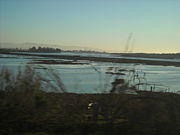Difference between revisions of "Elkhorn Slough National Estuarine Research Reserve (ESNERR)"
(→Training Activities) |
(→References) |
||
| Line 51: | Line 51: | ||
==References== | ==References== | ||
| − | ESNERR Management Plan 2007-2011 (let's add a link to this document) | + | * ESNERR Management Plan 2007-2011 (let's add a link to this document) |
| − | + | * http://www.nerrs.noaa.gov/BGDefault.aspx?ID=61 | |
| − | + | ||
Revision as of 14:37, 1 February 2011
Contents
NERRS
NERRS was established by the Coastal Zone Management Act of 1972. The research reserves includes 28 areas akkl representing different biological ecosystems. NERRS is in partnership with NOAA, which provides funding and national assistance.
ESNERR
- 1,439 acre Reserve
- one of 27 National Estuarine Research Reserves
- largest of thirteen sanctuaries in the National Marine Sanctuary System
- run by National Oceanic and Atmospheric Administration (NOAA) and managed by the California Department of Fish and Game (CDFG).
Mission
“The mission of the Elkhorn Slough National Estuarine Research Reserve is to improve the understanding and stewardship of Elkhorn Slough and its watershed.”
Conservation Targets
- 1. Tidal estuary
- 2. Coastal prairie/Coastal scrub
- 3. Maritime chaparral
- 4. Riparian/Freshwater wetlands
- 5. Coast live oak woodlands
Research
The research and monitoring activities for ESNERR are shaped around national plans that help to establish the priorities, goals and implementation approaches for the program. ESNERR partners with the Elkhorn Slough Foundation in research, outreach, and training activities. ESNERR designs all research around the defined goals of the National Estuarine Research Reserve system. These goals are as follows:
- promote public, federal and state use of the areas
- address ecosystem issues that have been identified by previous research
- conduct research to better understand the area
Research activities at ESNERR are focused on the following topics:
- 1. Eutrophication, effects of non-point source pollution and/or nutrient dynamics;
- 2. Habitat conservation and/or restoration;
- 3. Biodiversity and/or the effects of invasive species;
- 4. Mechanisms for sustaining resources within estuarine ecosystems; or
- 5. Economic, sociological, and/or anthropological research applicable to estuarine ecosystem management
Training Activities
A primary goal of ESNERR is “Educate the Community about the Watershed and Inspire Them to Consider Environmental Conservation When Making Decisions Affecting Elkhorn Slough and Its Watershed”. In order to achieve this ESNERR has made a continuous effort to reach out to the community through educational training programs and activities.These outreach programs and workshops cater to a variety of audiences, but the four primary programs are:
- The Coastal Training Program: offers workshops promoting Collaborative Ecosystem Management, workgroups and scientific review to local decision makers
- School Programs: educational field trips and student outreach programs
- Public Education: Interpretive Hiking Trails and Visitor Center
- Volunteer Programs
ESNERR also offers courses for those who are interested in developing a better understanding the estuarine system.
References
- ESNERR Management Plan 2007-2011 (let's add a link to this document)
- http://www.nerrs.noaa.gov/BGDefault.aspx?ID=61
